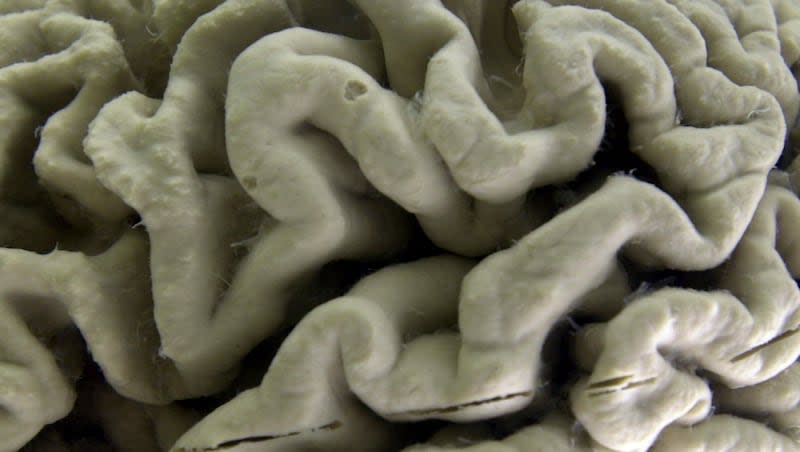Gene thought to raise risk for Alzheimer’s may cause it

Having two copies of a gene long believed to increase risk of Alzheimer’s disease may actually be a “new genetic form” of the degenerative neurological disease.
That’s according to a new study that found more than 95% of individuals over age 65 with two copies of the APOE4 gene show biological characteristics of the disease’s pathology when spinal fluid or positron emission tomography are examined.
The study, published in Nature Medicine, was conducted by researchers at the Sant Pau Research Institute, led by Dr. Juan Fortea, director of the memory unit of the institute’s Neurology Service, found that those with two of the gene variant also develop Alzheimer’s disease earlier than those who have different APOE variants. The findings might “represent a new genetic form of Alzheimer’s disease,” Fortea said in a news release.
“These data represent a reconceptualization of the disease or what it means to be homozygous for the APOE4 gene,” Fortea said in a written statement. “This gene has been known for over 30 years and it was known to be associated with a higher risk of developing Alzheimer’s disease. But now we know that virtually all individuals with this duplicated gene type develop Alzheimer’s biology. This is important because they represent between 2 and 3% of the population.”
It’s also crucial to note that not everyone who has both APOE4 genes develops Alzheimer’s symptoms. Researchers are trying to understand what makes some — the minority of the double APOE4 carriers — different.
The study design
As CNN explained, “This shifting appreciation of inherited risk, researchers say, is due to a better understanding of the role of a fourth gene that carries the blueprints to make a lipid-carrying protein called apolipoprotein E, known as APOE. APOE ferries cholesterol throughout the body and brain and is thought to play a role in depositing or sweeping away sticky beta amyloid plaques, which are one hallmark of Alzheimer’s.”
The APOE gene has different haplotypes. APOE3 is the most common and is considered neutral, neither increasing or decreasing risk of Alzheimer’s disease. APOE2 is thought to be protective against Alzheimer’s. And because one gene comes from each parent, there are combinations believed to raise or decrease risk somewhat.
“Rarely, people can have APOE4 and have a lot of beta amyloid in their brain but not have symptoms, perhaps because of other genetic or environmental factors that protect their brains at the same time. In the large dataset of nearly 3,300 brains kept by the National Alzheimer’s Coordinating Center, for example, 273 individuals had two copies of the APOE4 gene, and 240, or 88%, had dementia,” CNN reported.
The new study included data from 3,297 individuals whose brains were donated for research and 10,039 in clinical study for Alzheimer’s disease. The researchers found that almost all of those who had both APOE4 genes — which means one copy inherited from each parent — had some Alzheimer’s disease pathology and “had significantly higher levels of (Alzheimer’s) biomarkers from age 55 compared to APOE3 homozygotes. By age 65, nearly all had abnormal amyloid levels in cerebrospinal fluid, and 75% had positive amyloid scans, with the prevalence of these markers increasing with age, indicating near-full penetrance of AD biology in APOE4 homozygotes.
The study said the age of symptom onset was also earlier, at just over 65 years of age.
Symptoms for those with a pair of APOE4 genes also developed seven to 10 years earlier than with other older adults who develop Alzheimer’s.
Until this study, it was thought that the only genetic form of Alzheimer’s disease was the early-onset form, which is quite rare and strikes between 30 and 60 years of age.
Future treatment target?
Dr. Reisa Sperling, a study co-author at Brigham and Women’s Hospital in Boston, told The Associated Press that the research means it is vital to target treatments toward the APOE4 gene. The article noted that “some doctors won’t offer the only drug that has been shown to modestly slow the disease, Leqembi, to people with the gene pair because they’re especially prone to a dangerous side effect.”
Said Sperling, “This data for me says wow, what an important group to be able to go after before they become symptomatic.”
The study authors hope the findings will aid development of prevention strategies, clinical trials and targeted treatment for people with two copies of the APOE4 gene, according to background material on the study. In the release, Dr. Alberto Lleó, a researcher in the Dementia Neurobiology Group at the Sant Pau Research Institute, who directs Neurology Service there, said the finding reinforces that specific prevention strategies are needed.
According to CNN, “The important takeaway from the study, said Dr. Constantine Lyketsos, director of the memory and Alzheimer’s treatment center at Johns Hopkins, is that Alzheimer’s disease shouldn’t be treated as a monolith. Rather, it shows that there are different forms of the disease that need personalized treatment.”
Said Lyketsos, who was not involved in the study, “The point is, we need to start doing precision medicine and breaking it down. Start with genetics.”
Experts don’t currently suggest gene testing for an APOE variant as a routine part of diagnosis. The study authors suggest that might need to be reconsidered.

